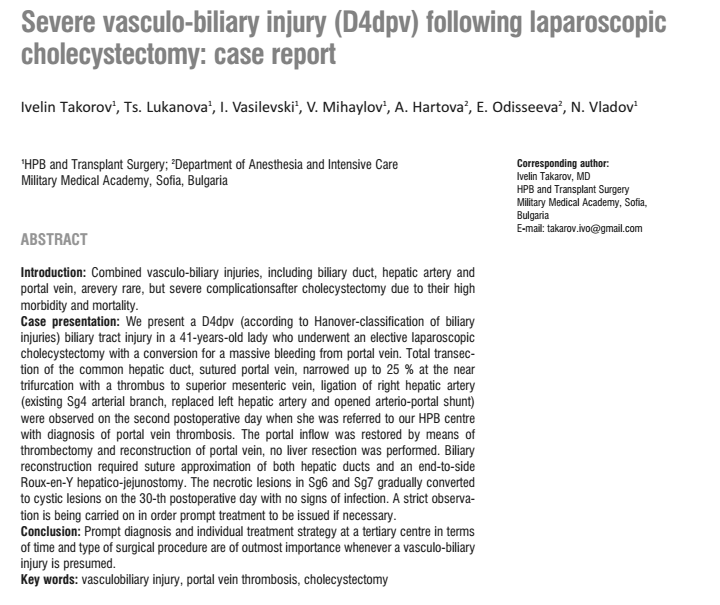Autori:
Ivelin Takorov1, Ts. Lukanova1, I. Vasilevski1, V. Mihaylov1, A. Hartova2, E. Odisseeva2, N. Vladov1
1 – HPB and Transplant Surgery; 2 – Department of Anesthesia and Intensive Care Military Medical Academy, Sofia, Bulgaria
Rezumat:
Introduction: Combined vasculo-biliary injuries, including biliary duct, hepatic artery and portal vein, arevery rare, but severe complicationsafter cholecystectomy due to their high morbidity and mortality.
Case presentation: We present a D4dpv (according to Hanover-classification of biliary injuries) biliary tract injury in a 41-years-old lady who underwent an elective laparoscopic cholecystectomy with a conversion for a massive bleeding from portal vein. Total transection of the common hepatic duct, sutured portal vein, narrowed up to 25 % at the near trifurcation with a thrombus to superior mesenteric vein, ligation of right hepatic artery (existing Sg4 arterial branch, replaced left hepatic artery and opened arterio-portal shunt) were observed on the second postoperative day when she was referred to our HPB centre with diagnosis of portal vein thrombosis. The portal inflow was restored by means of thrombectomy and reconstruction of portal vein, no liver resection was performed. Biliary reconstruction required suture approximation of both hepatic ducts and an end-to-side Roux-en-Y hepatico-jejunostomy. The necrotic lesions in Sg6 and Sg7 gradually converted to cystic lesions on the 30-th postoperative day with no signs of infection. A strict observation is being carried on in order prompt treatment to be issued if necessary.
Conclusion: Prompt diagnosis and individual treatment strategy at a tertiary centre in terms of time and type of surgical procedure are of outmost importance whenever a vasculo-biliary injury is presumed.
Publicat:
Case presentation: We present a D4dpv (according to Hanover-classification of biliary injuries) biliary tract injury in a 41-years-old lady who underwent an elective laparoscopic cholecystectomy with a conversion for a massive bleeding from portal vein. Total transection of the common hepatic duct, sutured portal vein, narrowed up to 25 % at the near trifurcation with a thrombus to superior mesenteric vein, ligation of right hepatic artery (existing Sg4 arterial branch, replaced left hepatic artery and opened arterio-portal shunt) were observed on the second postoperative day when she was referred to our HPB centre with diagnosis of portal vein thrombosis. The portal inflow was restored by means of thrombectomy and reconstruction of portal vein, no liver resection was performed. Biliary reconstruction required suture approximation of both hepatic ducts and an end-to-side Roux-en-Y hepatico-jejunostomy. The necrotic lesions in Sg6 and Sg7 gradually converted to cystic lesions on the 30-th postoperative day with no signs of infection. A strict observation is being carried on in order prompt treatment to be issued if necessary.
Conclusion: Prompt diagnosis and individual treatment strategy at a tertiary centre in terms of time and type of surgical procedure are of outmost importance whenever a vasculo-biliary injury is presumed.
Publicat:
J. Transl. Med. Res 2015;20(3):157-161
[gview file=”https://www.chirurgiehbp.ro/wp-content/uploads/2016/08/2015-3-157.pdf”]

